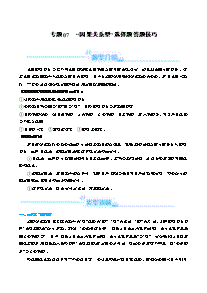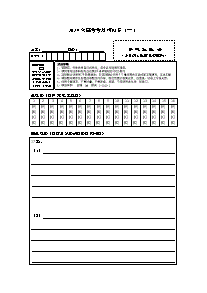2024年新高考英语二轮复习【培优小题狂练】专题10阅读理解“写作意图”题(考情+技法+真题+模拟)解析版【近年高考考情】1.(2023▪新高考I卷▪B篇)26题2.(2023▪浙江1月卷▪D篇)34题3.(2022▪新高考I卷▪C篇)28题4.(2020▪新高考卷▪C篇)31题【实用解题妙招】 一、设问方式1.What’sthewriter’spurposeinthistext?2.Thepurposeofthewritertowritethepassageis__________.3.Bytellingthestoryof...,theauthorintendsto________.二、实用妙招每篇文章都有一个特定的写作目的,或是向读者传递某个信息,或是愉悦读者,或是讲授某个道理。而这些信息通常并不是明确表达出来,而是隐含在文章之中。因此,这类问题要求考生在理解文章总体内容的基础上,去领会作者的言外之意。1.主旨推断法。写作意图与文章主旨密切相关,因此,解答这类题跟解答主旨大意题和选择文章标题一样,用略读法,即重点关注文章首尾段和各段的首尾句,找到主题句,抓住文章主旨,然后由主旨来推断作者的写作目的。议论文、新闻报道、说明文等,其主题句多在文首。2.文体推断法。①应用文广告的目的是吸引更多顾客、游客、读者、订户、观众等订阅或前往(toattractreaders)。②记叙文的目的是分享有趣的经历、告诉一个有趣的故事(toentertainreaders)、或给读者某种启示。③说明文的目的是使读者获得某种知识(toinformreaders),提出建议、劝告或呼吁有关部门给予重视。④议论文的目的通常是说服读者接受或赞同某一观点(topersuadereaders),倡导某种做法等。【高考真题再练】 1.(2023新高考I卷B篇)记叙文WhenJohnToddwasachild,helovedtoexplorethewoodsaroundhishouse,observinghownaturesolvedproblems.Adirtystream,forexample,oftenbecameclearafterflowingthroughplantsandalongrockswheretinycreatureslived.Whenhegotolder,Johnstartedtowonderifthisprocesscouldbeusedtocleanupthemessespeopleweremaking.Afterstudyingagriculture,medicine,andfisheriesincollege,Johnwentbacktoobservingnatureandaskingquestions.Whycancertainplantstrapharmfulbacteria(细菌)?Whichkindsoffishcaneatcancer-causingchemicals?Withtherightcombinationofanimalsandplants,hefigured,maybehecouldcleanupwastethewaynaturedid.Hedecidedtobuildwhathewouldlatercallaneco-machine.ThetaskJohnsetforhimselfwastoremoveharmfulsubstancesfromsomesludge(污泥).First,heconstructedaseriesofclearfiberglasstanksconnectedtoeachother.Thenhewentaroundtolocalpondsandstreamsandbroughtbacksomeplantsandanimals.Heplacedtheminthetanksandwaited.Littlebylittle,thesedifferentkindsoflifegotusedtooneanotherandformedtheirownecosystem.Afterafewweeks,Johnaddedthesludge.Hewasamazedattheresults.Theplantsandanimalsintheeco-machinetookthesludgeasfoodandbegantoeatit!Withinweeks,ithadallbeendigested,andallthatwasleftwaspurewater.Overtheyears,Johnhastakenonmanybigjobs.Hedevelopedagreenhouse—likefacilitythattreatedsewage(污水)from1,600homesinSouthBurlington.Healsodesignedaneco-machinetocleancanalwaterinFuzhou,acityinsoutheastChina.“Ecologicaldesign”isthenameJohngivestowhathedoes.“LifeonEarthiskindofaboxofsparepartsfortheinventor,”hesays.“Youputorganismsinnewrelationshipsandobservewhat’shappening.Thenyouletthesenewsystemsdeveloptheirownwaystoself-repair.”24.WhatcanwelearnaboutJohnfromthefirsttwoparagraphs?A.Hewasfondoftraveling. B.Heenjoyedbeingalone.C.Hehadaninquiringmind. D.Helongedtobeadoctor.25.WhydidJohnputthesludgeintothetanks?A.Tofeedtheanimals. B.Tobuildanecosystem.C.Toprotecttheplants. D.Totesttheeco-machine.26.Whatistheauthor’spurposeinmentioningFuzhou?A.ToreviewJohn’sresearchplans. B.ToshowanapplicationofJohn’sidea.C.TocompareJohn’sdifferentjobs. D.ToerasedoubtsaboutJohn’sinvention.27.WhatisthebasisforJohn’swork?A.Naturecanrepairitself. B.Organismsneedwatertosurvive.C.LifeonEarthisdiverse. D.Mosttinycreaturesliveingroups.【答案】24.C25.D26.B27.A【导语】这是一篇记叙文。文章讲述了JohnTodd从小就很爱思考且好学,他建造了一个生态机器,利用自然可以自我修复的原理来净化污水。24.细节理解题。根据第一段“WhenJohnToddwasachild,helovedtoexplorethewoodsaroundhishouse,observinghownaturesolvedproblems.Adirtystream,forexample,oftenbecameclearafterflowingthroughplantsandalongrockswheretinycreatureslived.Whenhegotolder,Johnstartedtowonderifthisprocesscouldbeusedtocleanupthemessespeopleweremaking.(当约翰·托德还是个孩子的时候,他喜欢探索房子周围的树林,观察大自然是如何解决问题的。例如,一条肮脏的小溪流经植物和微小生物居住的岩石后,往往会变得清澈。长大后,约翰开始思考这个过程是否可以用来清理人们制造的混乱)”以及第二段“Afterstudyingagriculture,medicine,andfisheriesincollege,Johnwentbacktoobservingnatureandaskingquestions.Whycancertainplantstrapharmfulbacteria(细菌)?Whichkindsoffishcaneatcancer-causingchemicals?(在大学学习了农业、医学和渔业之后,约翰又回到了观察自然和提出问题的生活中。为什么某些植物能捕获有害细菌?哪些鱼类会食用致癌化学物质?)”可知,约翰聪颖好学、好奇心很强。故选C。25.细节理解题。根据第三段“Afterafewweeks,Johnaddedthesludge.(几个星期后,约翰把污泥加了进去)”以及倒数第三段“Hewasamazedattheresults.Theplantsandanimalsintheeco-machinetookthesludgeasfoodandbegantoeatit!Withinweeks,ithadallbeendigested,andallthatwasleftwaspurewater.(他对结果感到惊讶。生态机器里的动植物把污泥当成了食物,开始吃了起来!几周之内,它就被消化了,只剩下纯净水)”可知,约翰把污泥放进罐子里是为了测试生态机器。故选D。26.推理判断题。根据倒数第二段“Overtheyears,Johnhastakenonmanybigjobs.Hedevelopedagreenhouse—likefacilitythattreatedsewage(污水)from1,600homesinSouthBurlington.Healsodesignedaneco-machinetocleancanalwaterinFuzhou,acityinsoutheastChina.(这些年来,约翰承担了许多重大工作。他开发了一个类似温室的设施,可以处理来自南伯灵顿1600户家庭的污水。他还设计了一种生态机器来清洁中国东南部城市福州的运河水)”可推知,作者提到福州的目的是展示约翰想法的应用。故选B。27.推理判断题。根据最后一段“Youputorganismsinnewrelationshipsandobservewhat’shappening.Thenyouletthesenewsystemsdeveloptheirownwaystoself-repair.(你把生物体放在新的关系中,观察会发生什么。然后让这些新系统自行发展自我修复的方式)”可知,约翰工作的基础是自然可以自我修复。故选A。2.(2023浙江1月卷D篇)说明文AccordingtotheSolarEnergyIndustryAssociation,thenumberofsolarpanelsinstalled(安装)hasgrownrapidlyinthepastdecade,andithastogrowevenfastertomeetclimategoals.Butallofthatgrowthwilltakeupalotofspace,andthoughmoreandmorepeopleaccepttheconceptofsolarenergy,fewlikelargesolarpanelstobeinstallednearthem.Solardeveloperswanttoputuppanelsasquicklyandcheaplyaspossible,sotheyhaven’tgivenmuchthoughttowhattheyputunderthem
专题10【培优小题狂练】阅读理解“写作意图”题(考情+技法+真题+模拟)-2024年新高考英语二轮复
你可能还喜欢
购买VIP会员享超值特权
VIP专享免费下载,付费文档最高省50%
免费下载
付费折扣
身份标识
文档工具
限时7.4元/月购买VIP
相关推荐
-
专题08 【培优小题狂练】阅读理解“文章大意”题(考情+技法+真题+模拟)-2024年新高考英语二轮
2024-01-06 15:57
 15页
15页 -
专题08 【培优小题狂练】阅读理解“文章大意”题(考情+技法+真题+模拟)-2024年新高考英语二轮
2024-01-06 15:57
 23页
23页 -
专题07 【培优小题狂练】阅读理解“段落大意”题(考情+技法+真题+模拟)-2024年新高考英语二轮
2024-01-06 15:57
 18页
18页 -
专题07 【培优小题狂练】阅读理解“段落大意”题(考情+技法+真题+模拟)-2024年新高考英语二轮
2024-01-06 15:57
 29页
29页 -
专题11 【培优小题狂练】阅读理解“写作手法”题(考情+技法+真题+模拟)-2024年新高考英语二轮
2024-01-06 15:58
 28页
28页 -
专题11 【培优小题狂练】阅读理解“写作手法”题(考情+技法+真题+模拟)-2024年新高考英语二轮
2024-01-06 15:58
 18页
18页 -
专题12 【培优小题狂练】阅读理解“猜测词义1”题(考情+技法+真题+模拟)-2024年新高考英语二
2024-01-06 15:58
 21页
21页 -
专题12 【培优小题狂练】阅读理解“猜测词义1”题(考情+技法+真题+模拟)-2024年新高考英语二
2024-01-06 15:58
 32页
32页













